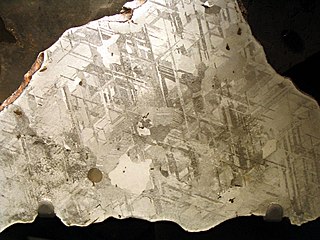
Kamacite is an alloy of iron and nickel, which is found on Earth only in meteorites. According to the International Mineralogical Association (IMA) it is considered a proper nickel-rich variety of the mineral native iron. The proportion iron:nickel is between 90%:10% and 95%:5%; small quantities of other elements, such as cobalt or carbon may also be present. The mineral has a metallic luster, is gray and has no clear cleavage although its crystal structure is isometric-hexoctahedral. Its density is about 8 g/cm3 and its hardness is 4 on the Mohs scale. It is also sometimes called balkeneisen.
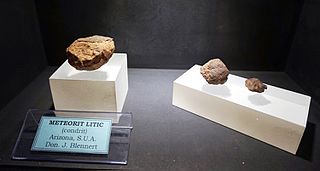
In meteoritics, a meteorite classification system attempts to group similar meteorites and allows scientists to communicate with a standardized terminology when discussing them. Meteorites are classified according to a variety of characteristics, especially mineralogical, petrological, chemical, and isotopic properties.

A chondrule is a round grain found in a chondrite. Chondrules form as molten or partially molten droplets in space before being accreted to their parent asteroids. Because chondrites represent one of the oldest solid materials within the Solar System and are believed to be the building blocks of the planetary system, it follows that an understanding of the formation of chondrules is important to understand the initial development of the planetary system.

A chondrite is a stony (non-metallic) meteorite that has not been modified, by either melting or differentiation of the parent body. They are formed when various types of dust and small grains in the early Solar System accreted to form primitive asteroids. Some such bodies that are captured in the planet's gravity well become the most common type of meteorite by arriving on a trajectory toward the planet's surface. Estimates for their contribution to the total meteorite population vary between 85.7% and 86.2%.

Iron meteorites, also known as siderites, or ferrous meteorites, are a type of meteorite that consist overwhelmingly of an iron–nickel alloy known as meteoric iron that usually consists of two mineral phases: kamacite and taenite. Most iron meteorites originate from cores of planetesimals, with the exception of the IIE iron meteorite group

The Fukang meteorite is a meteorite that was found in the mountains near Fukang, China in 2000. It is a pallasite—a type of stony–iron meteorite with olivine crystals. It is estimated to be 4.5 billion years old.

The LL chondrites are a group of stony meteorites, the least abundant group of the ordinary chondrites, accounting for about 10–11% of observed ordinary-chondrite falls and 8–9% of all meteorite falls. The ordinary chondrites are thought to have originated from three parent asteroids, with the fragments making up the H chondrite, L chondrite and LL chondrite groups respectively. The composition of the Chelyabinsk meteorite is that of a LL chondrite meteorite. The material makeup of Itokawa, the asteroid visited by the Hayabusa spacecraft which landed on it and brought particles back to Earth also proved to be type LL chondrite.

Heazlewoodite, Ni3S2, is a rare sulfur-poor nickel sulfide mineral found in serpentinitized dunite. It occurs as disseminations and masses of opaque, metallic light bronze to brassy yellow grains which crystallize in the trigonal crystal system. It has a hardness of 4, a specific gravity of 5.82. Heazlewoodite was first described in 1896 from Heazlewood, Tasmania, Australia.

The Allende meteorite is the largest carbonaceous chondrite ever found on Earth. The fireball was witnessed at 01:05 on February 8, 1969, falling over the Mexican state of Chihuahua. After it broke up in the atmosphere, an extensive search for pieces was conducted and over 2 tonnes were recovered. The availability of large quantities of samples of the scientifically-important chondrite class has enabled numerous investigations by many scientists; it is often described as "the best-studied meteorite in history." The Allende meteorite has abundant, large calcium–aluminium-rich inclusions (CAI), which are among the oldest objects formed in the Solar System.

Park Forest is an L5 chondrite meteorite that fell on 26 March 2003 in Illinois, United States.
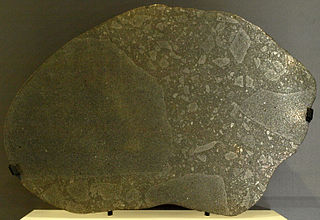
Enstatite chondrites are a rare form of meteorite, rich in the mineral enstatite. Only about 200 E-Type chondrites are currently known, comprising about 2% of the chondrites that fall on Earth. There are two main subtypes: EH and EL, classified based on their iron content.
CI chondrites, also called C1 chondrites or Ivuna-type carbonaceous chondrites, are a group of rare carbonaceous chondrite, a type of stony meteorite. They are named after the Ivuna meteorite, the type specimen. CI chondrites have been recovered in France, Canada, India, and Tanzania. Their overall chemical composition closely resembles the elemental composition of the Sun, more so than any other type of meteorite.
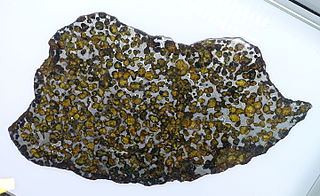
The Springwater meteorite is a stony-iron pallasite, found near Springwater, Saskatchewan in 1931. At that time the find consisted of three large masses (38.6 kilograms, 18.6 kilograms and 10.6 kilograms. Other fragments have been found recently, including a 53 kilograms individual in 2009 that is now in the Royal Ontario Museum.

Acapulcoites are a group of the primitive achondrite class of stony meteorites.

The Dronino meteorite is a 40-kilogram (88 lb) iron meteorite that was found in the Ryazan Oblast of Russia in July 2000. It is classified as an ataxite.
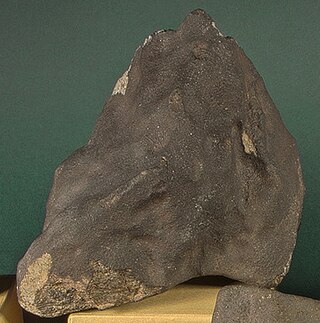
The Tamdakht meteorite fell near Ouarzazate, Morocco on 20 December 2008 producing a strewn field of approximately 25 kilometres (16 mi) by 2 kilometres (1.2 mi) and two small impact craters, one of about 1.1 metres diameter and 70 centimetres (28 in) depth at 31°09.8′N7°00.9′W and the other of about 20 centimetres (7.9 in) diameter and 10 centimetres (3.9 in) depth at 31°09.9′N07°02.3′W.
The Santa Vitoria do Palmar meteorite was found near the city of Santa Vitoria do Palmar in Brazil in 2003 and 2004.
This is a glossary of terms used in meteoritics, the science of meteorites.

Fifteen pieces of the Kainsaz meteorite were seen to fall near Kainsaz, Muslyumovo, Tatarstan on September 13, 1937. The largest weighed 102.5 kilograms (226 lb), the total weight was ~200 kilograms (440 lb). As of January 2013 pieces were on sale for ~US$100/g. Kainsaz is the only observed fall in Tatarstan.

The Jbilet Winselwan meteorite is a CM-type carbonaceous chondrite found in Western Sahara in 2013.






















